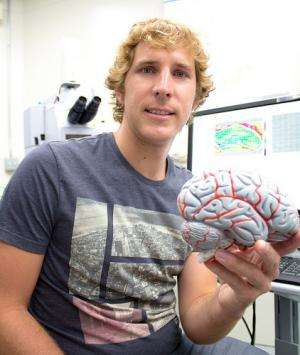Brain damage control: Scientists make big steps toward blocking the detrimental aftermath of stroke

Scientists have used a new imaging approach that utilizes powerful synchrotron-generated light to reveal aspects of the brain that had never before been seen. This discovery has uncovered a new method for better understanding how stroke damages the brain. In the future, knowledge gained from applying this novel imaging technique could be used to develop new therapies for minimizing the detrimental aftermath of stroke.
This research was funded by the Heart and Stroke Foundation of Canada and the Canadian Institutes of Health Research (CIHR) and conducted by Dr. Mark J. Hackett, from the University of Saskatchewan (U of S), as part of the Synchrotron Medical Imaging team. Their study was performed using the Canadian Light Source (CLS) and the Synchrotron Radiation Center (SRC) in Wisconsin.
The team conducted the experiment using a powerful infrared microscope technique on the synchrotron light beamlines at the CLS and SRC. Their research was featured on the cover of the July 2013 issue of ACS Chemical Neuroscience.
Stroke is the third leading cause of death in Canadians according to Statistics Canada.
According to Dr. Hackett, a stroke is similar to lighting the fuse of a bomb - it activates pathways in the brain that may later cause severe brain damage. Dr. Hackett and the team investigated and validated the use of a new imaging approach to study chemical pathways in the brain. Their results highlighted the tremendous potential of the imaging method. They are now using this method to study the mechanisms of the pathways initiated by stroke so they can potentially block them in the future – minimizing the detrimental aftermath of stroke and defusing the bomb.
The initial research focussed on imaging the cerebellum and hippocampus portions of the brain, which have critical roles: the cerebellum is involved in fine motor control, precision, balance, and coordination, while the hippocampus is responsible for memory.
"With such crucial responsibilities, it is important to thoroughly understand how these parts of the brain operate in order to protect them from a stroke," said Dr. Hackett.
Dr. Hackett and the team were the first to accurately image the total protein and lactic acid contents in specific brain cells in the cerebellum and hippocampus portions of the brain. The proteins and lactic acid they imaged are aspects of those potentially harmful pathways that lead to brain damage after stroke.
Proteins are essentially miniature machines that enable the human brain to function. Lactic acid plays a crucial role in the chemical cycle used to provide the energy required by these protein machines. Therefore, the new ability to image how the total protein and lactic acid contents of individual brain cells changes after stroke will allow investigators to gain greater insight into when, where, and how brain damage occurs.
"It's fantastic to work inside such an exciting research environment as the CLS with access to experts in both synchrotron science and neuroscience research so close to the U of S," Dr. Hackett said. "In addition to the results, the most exciting aspect of this research has been the teamwork between a number of scientists from diverse areas of expertise and multiple research institutions.
"I am fascinated by the chemical reasons behind how we think and how that information could be applied to help stroke victims."
The discoveries highlight the potential of this new imaging tool for helping to better understand how the brain and its chemical pathways function and malfunction. Such knowledge could be critical in blocking and defusing the damaging effects of stroke. In the future, this state-of-the-art imaging technique could also be applied in the search for a cure for other brain diseases, from Parkinson's disease to multiple sclerosis to Alzheimer's disease.
More information: "Subcellular Biochemical Investigation of Purkinje Neurons Using Synchrotron Radiation Fourier Transform Infrared Spectroscopic Imaging with a Focal Plane Array Detector," ACS Chemical Neuroscience, 2013, 4 (7), pp 1071–1080. DOI: 10.1021/cn4000346












